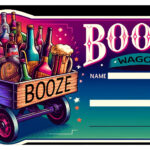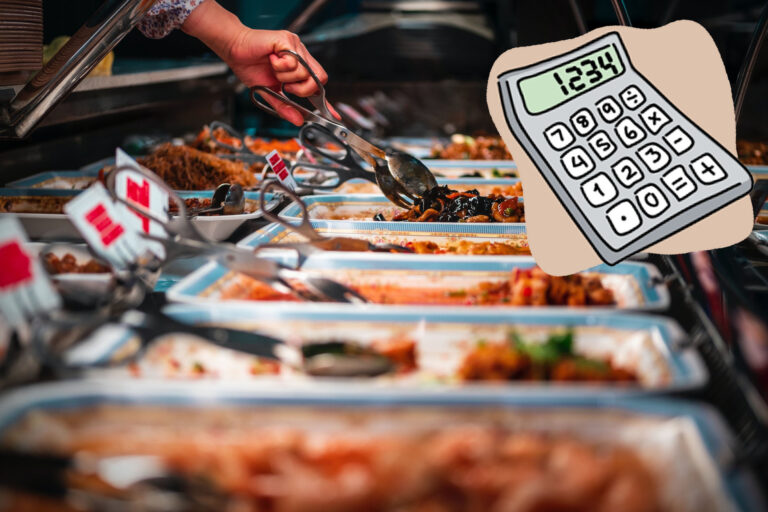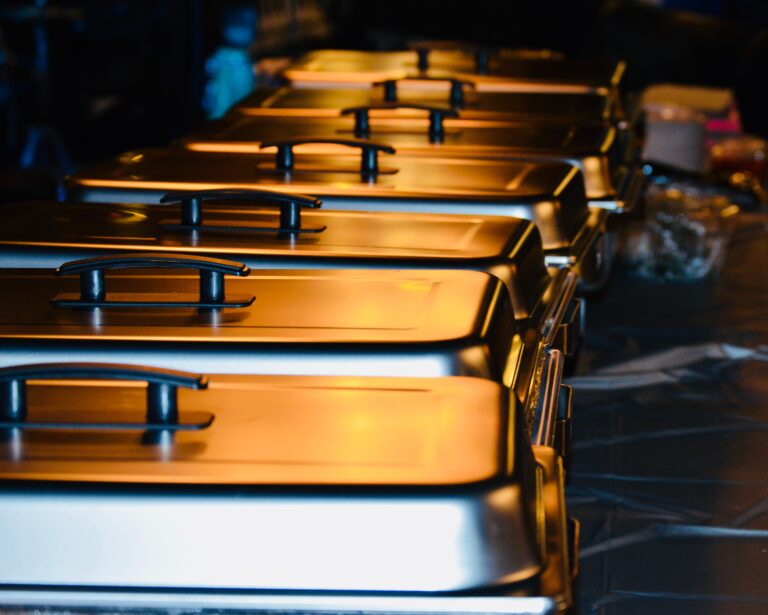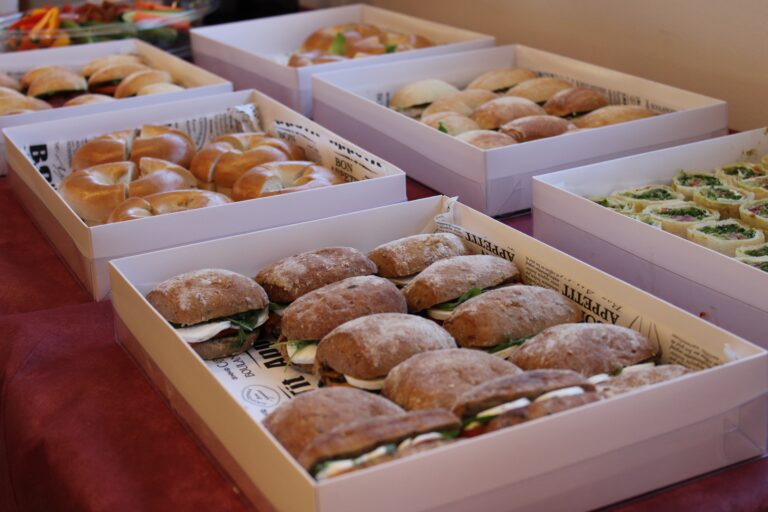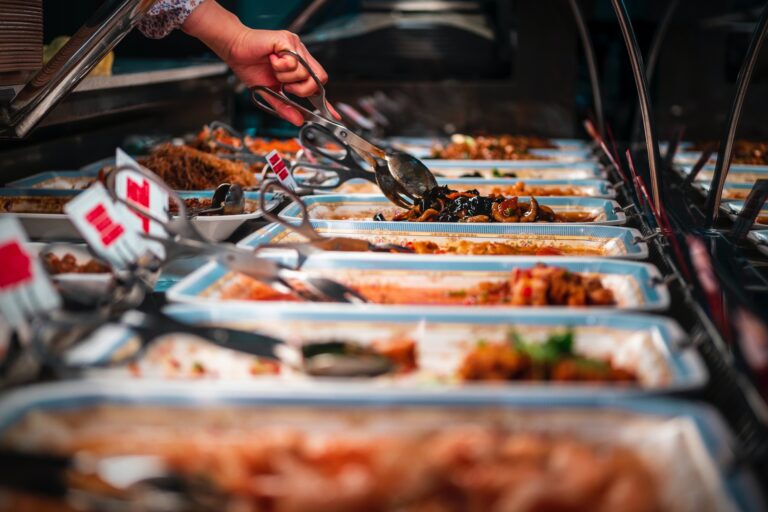Ensure Food Safety at a Benefit Fundraiser
Food safety is crucial when organizing a benefit fundraiser. By following proper guidelines and implementing necessary precautions, you can prevent foodborne illnesses and create a safe environment for all participants. From handling, preparing, and storing food to maintaining proper hygiene practices, our tips and guidelines will help you navigate the complexities of food safety, ensuring a successful and worry-free event.
To keep food safe at a fundraiser benefit, follow these essential guidelines: maintain proper temperature control, practice good hygiene, separate raw and cooked foods, ensure thorough cooking, and regularly sanitize surfaces and utensils. These measures mitigate the risk of foodborne illnesses, ensuring a safe and enjoyable event for all attendees.
| No. | Safety Tips |
|---|---|
| 1 | Maintain proper temperature control |
| 2 | Practice good hygiene |
| 3 | Separate raw and cooked foods |
| 4 | Ensure thorough cooking |
| 5 | Regularly sanitize surfaces and utensils |
Food Safety Measures for Your Benefit Fundraiser
Food Safety Measures for a Successful Benefit Fundraiser
When it comes to organizing a benefit fundraiser, ensuring food safety is paramount. Nobody wants their attendees leaving with more than just a full stomach! So, let’s dive into some detailed information on how to keep the food at your event safe and minimize the risk of foodborne illnesses.
Maintain Proper Temperature Control
Temperature control is key to preventing the growth of harmful bacteria. Keep hot foods hot (above 140°F/60°C) and cold foods cold (below 40°F/4°C) throughout the event. Use chafing dishes, hot plates, or slow cookers to keep hot food at a safe temperature, and place cold dishes on ice or in refrigerators.
Practice Good Hygiene
Proper hygiene practices are essential for preventing cross-contamination and the spread of germs. Ensure all food handlers wash their hands thoroughly with soap and water before handling food. Provide hand sanitizer stations for guests and encourage them to use them before indulging in the culinary delights.
Separate Raw and Cooked Foods
Avoid cross-contamination by keeping raw and cooked foods separate. Use different cutting boards, utensils, and plates for raw and cooked items. Ensure that any juices from raw meats or seafood do not come into contact with ready-to-eat foods.
Ensure Thorough Cooking
Proper cooking temperatures kill harmful bacteria, so make sure all food is cooked thoroughly. Use a food thermometer to check the internal temperature of meats, poultry, and seafood. For example, poultry should reach 165°F (74°C), and ground meats should reach 160°F (71°C).
Regularly Sanitize Surfaces and Utensils
To maintain a clean food preparation area, regularly sanitize surfaces and utensils. Use a solution of one tablespoon of unscented bleach mixed with one gallon of water to disinfect cutting boards, countertops, and utensils. Don’t forget to rinse them thoroughly afterward.
By following these guidelines, you can ensure that the food at your benefit fundraiser is not only delicious but also safe for everyone to enjoy. Remember, a well-executed event that prioritizes food safety will leave a lasting positive impression on your attendees and contribute to the overall success of your cause.
Essential Food Safety Practices at Benefit Fundraisers
- Temperature Guidelines:
- Temperature Danger Zone: 40°F (4°C) to 140°F (60°C)
- Safe Temperature for Poultry: 165°F (74°C)
- Safe Temperature for Ground Meats: 160°F (71°C)
- Food Safety Measures:
| Measure | Description |
|---|---|
| Maintain Temperature | Keep hot food above 140°F (60°C) and cold food below 40°F (4°C) |
| Practice Good Hygiene | Proper handwashing and hand sanitizer use |
| Separate Raw and Cooked | Use separate cutting boards, utensils, and plates for raw and cooked foods |
| Ensure Thorough Cooking | Use a food thermometer to check internal temperatures for proper cooking |
| Sanitize Surfaces | Regularly disinfect cutting boards, countertops, and utensils |
| Handle Homemade Dishes | Provide guidelines for safe handling and storage of homemade dishes |
| Non-Perishable Alternatives | Explore options for non-perishable food items for outdoor fundraisers |
| Communicate Information | Use signage and verbal reminders to communicate food safety information to attendees |
| Address Illness from Food | Provide assistance, document details, notify health authorities, and review food safety measures |
| Responsibly Handle Waste | Implement a waste management plan for proper disposal and donation of surplus food |
Importance of Food Handling and Storage
Proper food handling and storage practices play a crucial role in maintaining food safety at benefit fundraisers. Let’s explore some key aspects that deserve attention:
Safe Food Handling Practices
When it comes to handling food, there are a few important steps to keep in mind. First, ensure that all food handlers wash their hands thoroughly and frequently, especially after handling raw ingredients. Use disposable gloves when necessary to minimize direct contact.
Storage and Thawing Guidelines
Proper storage and thawing techniques are vital for preventing the growth of harmful bacteria. Store perishable items in the refrigerator, making sure to keep them separate from raw meats and seafood. Thaw frozen items in the refrigerator or use the microwave’s defrost function to promote even and safe thawing.
Buffet Setup Considerations
If you’re planning a buffet-style fundraiser, take some additional precautions to maintain food safety. Keep hot food items heated using chafing dishes or slow cookers, and ensure a continuous heat source to keep them at the proper temperature. Use ice trays or chilled serving platters to keep cold foods cool.
Allergen Awareness
It’s crucial to be mindful of potential allergens in the food you serve. Clearly label dishes that contain common allergens such as nuts, gluten, dairy, or shellfish. Consider offering alternative options for individuals with dietary restrictions or allergies to ensure everyone can partake in the culinary delights safely.
Remember, the more attention you pay to proper food handling and storage, the lower the risk of foodborne illnesses and the happier your attendees will be.
Collaborating with Reputable Food Vendors
When organizing a benefit fundraiser, you may consider collaborating with food vendors to provide a wider variety of options for your attendees. Here are some tips for selecting and working with reputable food vendors:
Verify Licenses and Certifications
Ensure that any food vendors you collaborate with hold the necessary licenses and certifications from local health departments. This demonstrates their commitment to food safety practices and compliance with regulations.
Discuss Food Safety Measures
Engage in open communication with potential vendors regarding their food safety practices. Inquire about their handling, preparation, and storage methods to ensure they align with your standards and expectations.
Sample Tastings
Consider arranging sample tastings with prospective vendors. This allows you to not only assess the quality and taste of their offerings but also observe their food handling and presentation practices.
Contractual Agreements
When finalizing agreements with food vendors, include clauses that specify adherence to food safety guidelines and compliance with local regulations. Clearly outline expectations regarding hygiene, temperature control, allergen awareness, and proper disposal of food waste.
Collaborating with reputable food vendors adds variety to your fundraiser while sharing the responsibility of ensuring food safety. By working together and prioritizing this aspect, you can deliver a remarkable experience that leaves a positive impact on your attendees.
Keep the momentum going and let’s continue exploring more aspects of benefit fundraiser food safety to ensure a comprehensive understanding and successful execution of your event.
How can I ensure the safety of homemade dishes brought by volunteers?
When it comes to homemade dishes brought by volunteers, it’s important to establish clear guidelines to maintain food safety. Encourage volunteers to follow proper food handling and storage practices at home, emphasizing the importance of washing hands, keeping ingredients refrigerated, and using clean utensils. Consider providing guidelines or recipe suggestions to ensure that the homemade dishes meet safety standards. Additionally, have volunteers label their dishes with the name and list of ingredients to help attendees with allergies or dietary restrictions make informed choices.
What are some alternatives to perishable food items for outdoor benefit fundraisers?
Outdoor benefit fundraisers can present challenges in terms of food safety, especially when it comes to perishable items. Consider offering non-perishable alternatives such as granola bars, trail mix, or individually packaged snacks. You can also explore options like fresh fruit, pre-packaged salads, or sandwiches made with non-perishable ingredients. Don’t forget to keep these items properly stored, away from direct sunlight, and at the appropriate temperature to maintain their quality and safety.
How can I effectively communicate food safety information to attendees?
Communication is key when it comes to ensuring food safety at your benefit fundraiser. Use clear signage to indicate food stations and provide important information, such as allergen warnings or special dietary considerations. Incorporate verbal reminders during announcements or speeches, emphasizing the importance of hand hygiene and safe food practices. Engage with attendees through social media or event websites, sharing tips and guidelines to create awareness and promote a safe dining experience.
What should I do if someone gets sick from the food at the event?
If someone falls ill after consuming food at your benefit fundraiser, it’s essential to address the situation promptly and professionally. Provide assistance to the affected individual and ensure they receive medical attention if necessary. Document any relevant details such as symptoms, food consumed, and contact information. Promptly notify your local health department and follow their guidance regarding reporting procedures and further investigation. Use this as an opportunity to review your food safety measures and make any necessary improvements for future events.
How can I responsibly handle food waste after the event?
Minimizing food waste and handling it responsibly is not only environmentally friendly but also crucial for food safety. Implement a waste management plan that includes proper disposal of perishable and non-perishable food items. Consider donating surplus food to local shelters or food banks, ensuring that all safety guidelines and regulations are followed. If composting is an option, separate food waste accordingly. By taking proactive steps in handling food waste, you contribute to a more sustainable and responsible event.
Addressing these common questions provides clarity and reassurance to organizers and attendees alike, fostering a safe and enjoyable experience at your benefit fundraiser.
Myth: Food prepared at home is always safe for consumption at a benefit fundraiser.
While homemade dishes can be delicious and made with love, it’s important to recognize that proper food safety practices are crucial, regardless of where the food is prepared. Home cooks should follow guidelines for safe food handling, storage, and temperature control to minimize the risk of foodborne illnesses. Encourage volunteers to maintain high standards of hygiene and provide clear instructions on safe food preparation to ensure the safety of homemade dishes.
Myth: A quick taste test is enough to determine if food is safe to eat.
Relying on our taste buds alone to assess the safety of food can be misleading. Harmful bacteria may not always alter the taste, appearance, or smell of food. It’s important to follow proper food safety guidelines, such as maintaining temperature control, preventing cross-contamination, and practicing good hygiene, to ensure the safety of the food. Don’t let your taste buds trick you into consuming something that may pose a risk.
Myth: Food left out for a short time is still safe to eat.
Leaving food at room temperature for an extended period can create a breeding ground for bacteria. Perishable items should not be left at room temperature for more than two hours (or one hour if the temperature exceeds 90°F/32°C). Even a short period of time can allow bacteria to multiply and increase the risk of foodborne illnesses. It’s best to promptly refrigerate or properly dispose of any perishable food items to ensure food safety.
The Power of Food Handlers Certification
When organizing a benefit fundraiser and assembling a team of volunteers, considering individuals who have their food handlers certification can be a brilliant idea. Not only does it demonstrate their commitment to food safety, but it also brings valuable expertise to the table. By asking a friend who already possesses their certification to volunteer, you can benefit from their in-depth knowledge of safe food handling practices, proper temperature control, and hygiene protocols.
Their certification serves as a testament to their understanding of the best practices to prevent foodborne illnesses, ensuring that the food served at your event is prepared and handled with utmost care. With a certified friend on board, you can have peace of mind knowing that you have a reliable resource who can guide and assist other volunteers in maintaining the highest standards of food safety throughout the benefit fundraiser.
Food Safety is Key at Your Benefit Fundraiser Meal
By following the valuable tips, guidelines, and insights laid out in this article, you can embark on your benefit fundraiser journey with confidence and enthusiasm. Rest assured that prioritizing food safety will not only create a safe environment for your attendees but also contribute to the overall success of your cause. As you raise funds for your loved one, remember that your dedication to ensuring the well-being of those who attend will leave a lasting impact. So, embrace the knowledge you’ve gained, infuse your event with creativity and passion, and watch as your efforts come together to make a meaningful difference. Get ready to inspire, connect, and raise both spirits and funds, all while keeping food safety at the heart of your endeavor.


